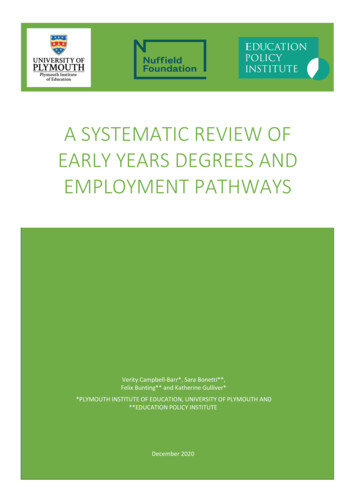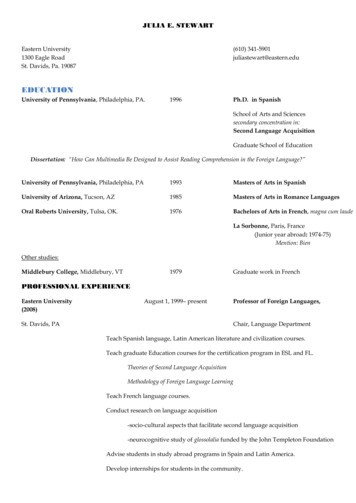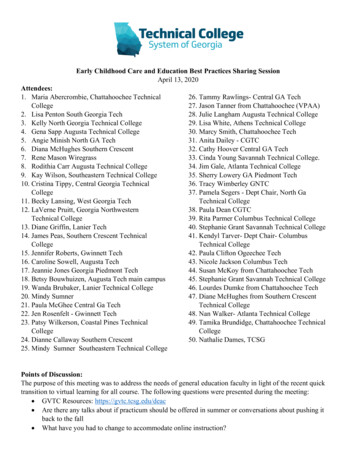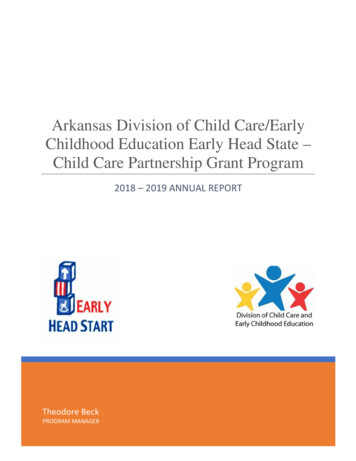
Transcription
A SYSTEMATIC REVIEW OFEARLY YEARS DEGREES ANDEMPLOYMENT PATHWAYSVerity Campbell-Barr*, Sara Bonetti**,Felix Bunting** and Katherine Gulliver**PLYMOUTH INSTITUTE OF EDUCATION, UNIVERSITY OF PLYMOUTH AND**EDUCATION POLICY INSTITUTEDecember 20200
About the AuthorsVerity Campbell-Barr is an Associate Professor in Early Childhood Studies and Associate Head ofResearch at Plymouth Institute of Education, University of Plymouth. Verity has over 15 years ofexperience researching early childhood education and care services. Her research interests centre onthe quality of early childhood services, particularly the role of the early childhood workforce insupporting the quality of services. She has a particular interest in the concept of child-centredness andwhat it means for quality pedagogic interactions within early years services and has co-led twoEuropean projects in this area. Verity has also undertaken international research on the knowledge,skills and attitudes for working in early childhood services. She has written extensively on quality andthe workforce in early childhood services and has recently published Professional Knowledge and Skillsin the Early Years with Sage Publishing.Sara Bonetti is Director of Early Years at the Education Policy Institute. Sara is the principal author of‘The early years workforce: A fragmented picture’ and ‘The early years workforce in England’. Prior tojoining EPI, Sara spent ten years working in the early years sector in the United States. She led datacollection efforts on topics such as funding and workforce professional development and conductedanalyses on areas such as educational leadership and systems integration. Sara has a doctorate inEducational Leadership with a focus on early childhood education from Mills College in Oakland,California.Felix Bunting is a researcher at the Education Policy Institute. Before joining EPI, Felix studied Physicsat the University of Oxford. Over the course of his studies, he interned as a quantitative analyst withinindustry, market research and public sector consultancy. He graduated with an MPhys in 2019, withhis Master’s project focused on the theoretical basis of machine learning.Katherine Gulliver is currently a PhD student at Plymouth Institute of Education, University ofPlymouth. Her PhD focuses on participatory research methods, special educational needsand/disabilities and inclusion. Before this, Katherine completed an MA in Special and InclusiveEducation on the Erasmus Mundus programme in Norway, UK and the Czech Republic, whichexamined parental perceptions of social inclusion. Katherine has worked on various research projectsthat involve systematic database searches, thematic analysis and a range of research methodologies.This includes a three stage project for PACEY (Professional Association for Childcare and Early Years)to establish an understanding of childminder sustainability in England and Wales.1
AcknowledgementsThis project was funded by the Nuffield Foundation. The Nuffield Foundation is an independentcharitable trust with a mission to advance social well-being. It funds research that informs social policy,primarily in Education, Welfare, and Justice. It also funds student programmes that provideopportunities for young people to develop skills in quantitative and scientific methods. The NuffieldFoundation is the founder and co-funder of the Nuffield Council on Bioethics and the Ada LovelaceInstitute. The Foundation has funded this project, but the views expressed are those of the authorsand not necessarily the Foundation. Visit www.nuffieldfoundation.orgWe would like to thank Eleanor Ireland at the Nuffield Foundation for managing the project and allmembers of the Advisory Group for their helpful insights throughout the project.The analysis presented in the second part of this report was carried out using data provided by theHigher Education Statistics Agency. Neither the Higher Education Statistics Agency Limited nor HESAServices Limited can accept responsibility for any inferences or conclusions derived by third partiesfrom data or other information supplied by the Higher Education Statistics Agency Limited or HESAServices Limited.2
ContentsAbout the Authors . 1Acknowledgements . 2Executive summary . 5Key findings . 5Conclusions . 7Background . 8Stage One: Systematic Review of Early Years Degrees in England . 10Identifying Degrees . 10Analysis . 10Structural Features of Early Years Degrees in England . 11Interpretive Features of Early Years Degrees in England. 14Professionalism and Pedagogy . 18Approaches for Focussing on the Child . 20Summary . 22Stage Two: Opportunities and Patterns of Employment of Early Years Graduates . 23Data and Methodology . 23Data source . 23Data validation . 23Key Findings . 24Student Characteristics . 24Course Characteristics . 26Employment Outcomes. 29Geographical Analysis . 32Further Study. 36Life and Course Satisfaction . 38Job Trajectory . 39Summary . 40Discussion and Conclusion . 42Limitations . 45Conclusions and Recommendations . 46Recommendations . 47Appendix 1: Identification and Analysis of Degrees . 49Structural Features . 50Suitability . 51Framework Analysis . 513
Coding Framework . 52Appendix 2: Derived Variables . 55Course Type . 55Job in the sector . 55References . 564
Executive summaryDegree-qualified staff in early years settings have been identified as contributing to the overall qualityof services and to improve children’s outcomes. Yet, despite the international recognition of theimportance of a graduate workforce for early years services, little is known about the structure orcontent of early years degrees available in England. In the last few years, several organisations havetried to provide some clarity through the development of competence frameworks, but none of theseare mandatory and there is still little information to ascertain what theoretical and/or practicalelements these degrees should contain. This leads to a fragmentation that is evident in, but goesbeyond, the array of degree types on offer.In addition, while degrees are recognised for their pedagogical contribution to the quality of earlyyears practices, the benefits in terms of employment conditions accruing from having a degree arenot evident. Fluctuating policy commitments have resulted in a two-tier system, whereby staff in themaintained sector are required to hold a degree with Qualified Teacher Status (QTS), while thecommitment for a graduate led workforce in the private, voluntary and independent (PVI) sectors hasbeen removed. On entry to the workforce, those with QTS have established mentoring provision, withlittle known about the provisions for those working in the PVI sector. It is not clear whether changesin policy have resulted in those obtaining early years degrees to select alternative pathways, and, ifso, what bearing this has on their earnings.Our goal was to fill in these evidence gaps by exploring the content of the full range of early yearsdegrees in England available during 2019 and the employment trajectories of early years graduatesfor 2012/13, the latest year for which suitable data is available.The first stage of the research undertook a mapping of the different types of early years degreesavailable in England (such as Bachelor of Education, Bachelor of Arts, Postgraduate Certificates inEducation, the historic Early Years Professional Status, and the current Early Years Teacher Status) andthe associated entry requirements, course content and practice (work-placement) arrangements. Thesecond stage of the analysis examined data on early years graduates’ outcomes to investigate entry(into programmes) and exit characteristics of students, as well as their employment pathways, suchas type of employment, geographical movement to find employment and earnings, three and a halfyears after graduation.Key findings Early years degree choices in England are highly fragmented. A search on the UCAS databaseidentified 320 degrees from which a prospective early years student in England could choose.Analysis of course descriptors identified variable entry requirements, particularly in relationto the UCAS entry points (ranging from 16 to 112) and whether there were core minimumrequirements, such as GCSEs in Mathematics, English and Science.Degree content and age specialisation are fragmented. Analysis of online course descriptorsdemonstrated that early years degrees cover a range of subjects, but with no obvious commoncore. References to the age foci of degrees extended beyond what might typically bedescribed as ‘early years’. Degrees had a strong employment orientation focussing primarilyon professional practice and reflection, alongside pedagogy (teaching and learning). And yet,they lacked clear references to future statutory aspects of working in the early years, such aschild protection and children’s rights.Work-placement arrangements are also fragmented, with links between theory and practicenot always strong or uniform. While some degrees ‘encouraged’ students to undertake workexperience/placements, others stipulated a set number of hours to be done, per term, yearor over the duration of the degree. In some instances, the degree was designed to be5
combined with paid employment. Detail on the work-placement arrangements was oftenunclear, including whether or not students would receive a mentor from either the universityor employer, and what processes were in place for assessment.The early years student population differ from the broader student population in a numberof ways. Almost half of the 2012/13 cohort was 30 years or older when they finished theircourse. While directly comparable figures are not available, when considering allundergraduates across the UK, in 2012/13 only 27 per cent of students were over the age of25. Additionally, early years students also had a non-traditional educational background, suchas level 3 vocational qualifications (36 per cent) and level 4/5 qualifications (27 per cent). Thissuggests that these courses are fulfilling a widening participation aim in terms of increasingthe age range of potential students and may allow for prior work experience among thisgroup.Students’ demographic characteristics are linked to the characteristics of the courses theyundertake and, in turn, have an impact on their employment opportunities. Of the cohortunder study, 41 per cent of early years students were studying part-time compared to 24 percent for all undergraduate students in England. The large proportion of part-time students isdriven significantly by the older student population, and may reflect a greater need orwillingness to balance study with work, care or other responsibilities. In addition, 30 per centof students studying early years courses were doing so as part of a foundation degree,compared to an average of 5 per cent of all students in England. Finally, only 5 per centenrolled in Initial Teacher Training or PGCE courses, despite these courses having guaranteedteacher training components and therefore likely to be linked to career incentives.The majority of early years graduates find employment with the sector but there is no realfinancial incentive to stay. Three and a half years after graduation, 56 per cent of the studentsin our sample were employed in the early years sector, 15 per cent worked in occupationsclassified as Managers and proprietors and 28 per cent found employment outside of thesector. The lowest earning group appears to be Managers and proprietors, with 60 per centearning less than 20,000 per year, compared to 47 per cent of those employed in the earlyyears sector as non managers/proprietors and 43 per cent of those employed outside of theearly years sector. Beside differences for those in managerial roles, however, there appearsto be little variation in pay between those inside and outside the sector, suggesting that evenfor those with a degree in early years there is little economic incentive to remain employedwithin the sector.There is a clear salary premium for those accessing early years courses with a moreacademic-oriented background and for pursuing teacher training. Three and a half yearsafter graduation, 43 per cent of students who entered with a degree or above earned morethan 25,000, compared to only 30 per cent of those entering with a level 3 academicqualification and 21 per cent of those entering with level 3 (vocational) qualification. Inaddition, 54 per cent of graduates without teacher training earned less than 20,000compared to only 21 per cent of those with teacher training; instead, 51 per cent of thosestudying teacher training courses earn over 25,000, compared to 23 per cent of thosewithout teacher training.The early years workforce is highly localised. The vast majority of early years studentstravelled less than 50km between their pre-university residence and study location (79 percent) and between their study and work location (77 per cent). We also observed a clearpreference for students to work close to their pre-university residence (92 per cent stay within50km), likely reflecting students “moving back” after completing their course. Meanwhile,teacher training courses are unequally distributed across the country, becoming a keydeterminant of which areas are likely to be well-served by the graduate workforce.6
ConclusionsThe goal of this study was to provide new insights into what an early years degree constitutes inEngland and the employment trajectories of graduates. The evidence gap in this important area ofearly years practice and policy has hindered advocacy efforts in support of a sustained policycommitment for a degree-qualified workforce in early years services. Meanwhile, fluctuating policycommitments for a graduate workforce across the sector have exacerbated a two-tier model betweengraduates obtaining QTS and those who do not. Data on graduate employment clearly shows anemployment premium amongst graduates with QTS.Although degree descriptors illustrate a strong employment focus in their content, there was muchvariability in the entry requirements, age focus, course content and work-placement arrangements.Despite the employment focus, there are questions as to whether degrees are covering content thatwill enable students to go on to work in early years services, such as having age specific childdevelopment knowledge and meeting statutory obligations around child protection and children’srights. The fragmentation in degrees presents a challenge for the quality of early years degrees due toa lack of clear expectations of the content covered for students or employers. In addition, thefragmentation is higher in the case of degrees without QTS that are more likely to lead to employmentin PVI settings compared to those with QTS, further exacerbating the negative consequences of thetwo-tier system.The geographical distribution of courses raises concerns around access to quality degrees that willfulfil employment ambitions if students are unable or unwilling to travel for study. The lack ofmovement is also reflected in employment trajectories, whereby an uneven distribution of courses islikely to reflect an uneven distribution of graduates within the workforce and within the country.Ultimately, the
1 About the Authors Verity Campbell-Barr is an Associate Professor in Early Childhood Studies and Associate Head of Research at Plymouth Institute of Education, University of Plymouth. Verity has over 15 years of experience researching earl











